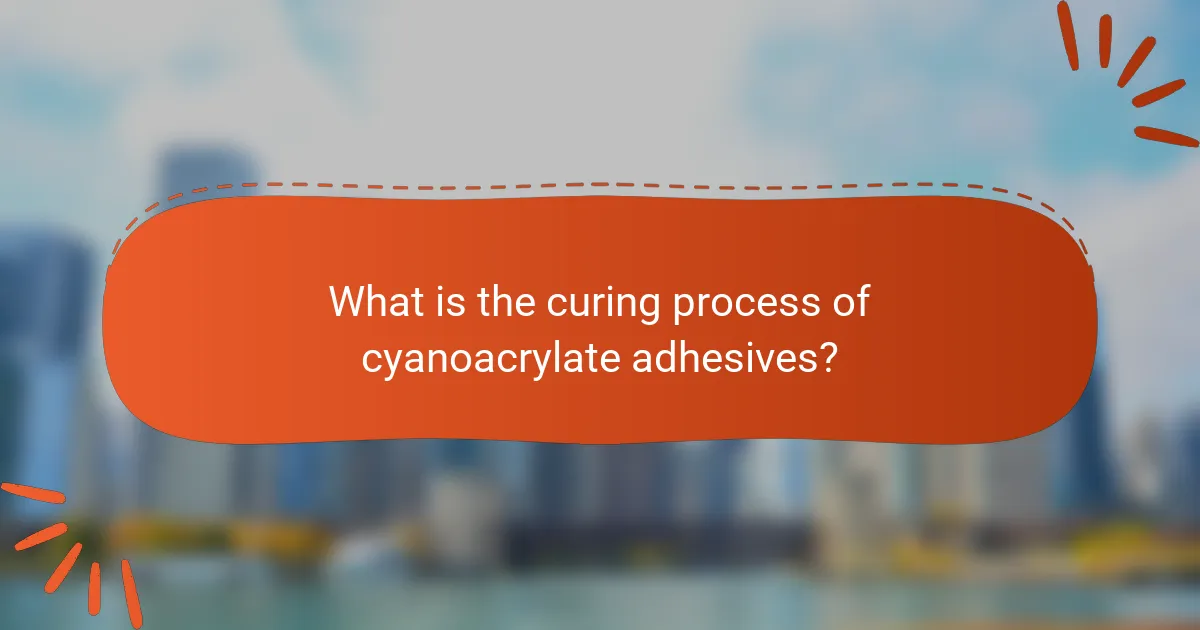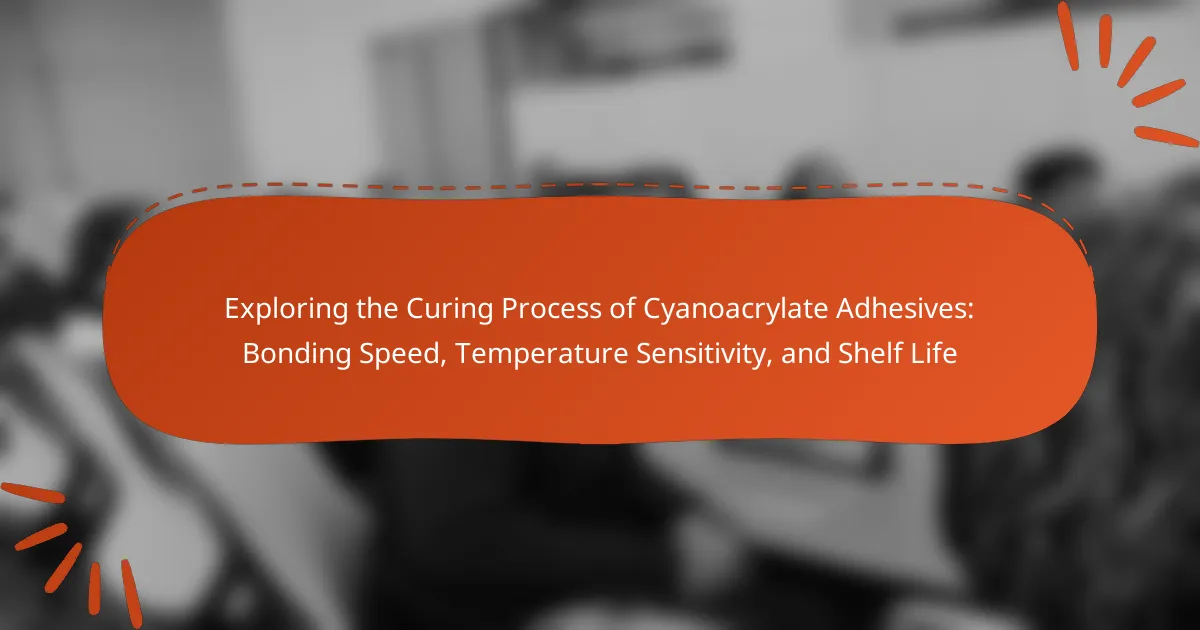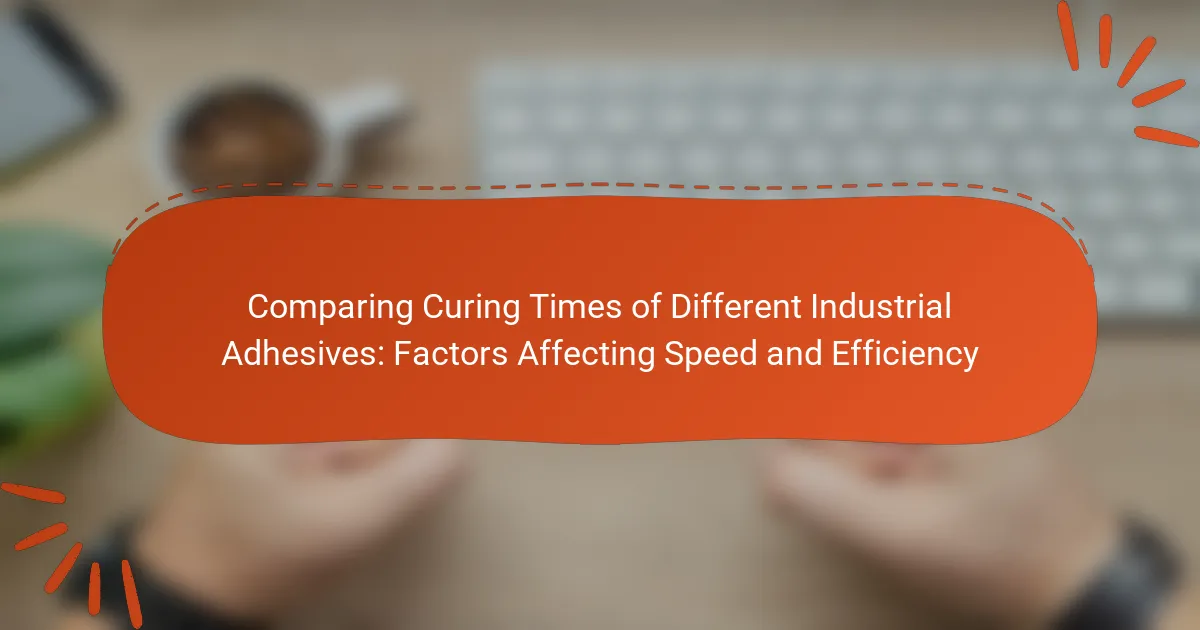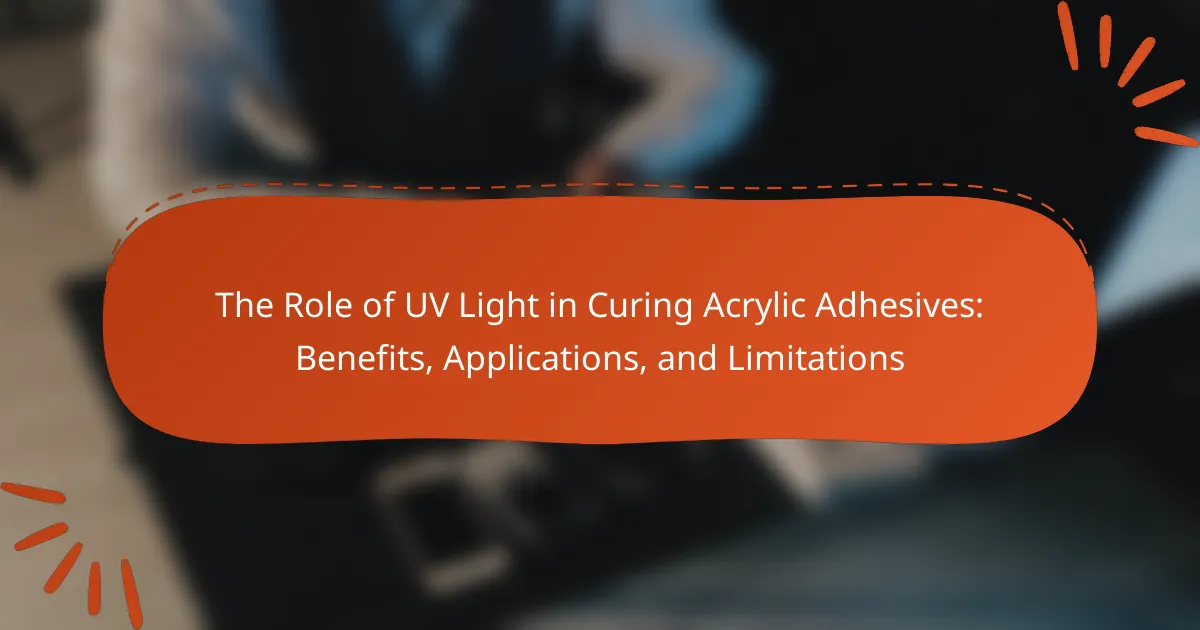Cyanoacrylate adhesives are known for their rapid curing process, which occurs through polymerization initiated by moisture in the air. The article explores how environmental factors, such as humidity and temperature, influence the curing speed and bond strength of these adhesives. It highlights that higher humidity can accelerate curing, while low humidity may slow it down, with optimal performance typically achieved between 20°C and 25°C. Additionally, proper surface preparation and application techniques are essential for maximizing bond strength and curing efficiency. Safety precautions for use and storage of cyanoacrylate adhesives are also discussed to ensure effective and safe application.

What is the curing process of cyanoacrylate adhesives?
The curing process of cyanoacrylate adhesives involves polymerization through moisture in the air. When cyanoacrylate comes into contact with moisture, it initiates a rapid chemical reaction. This reaction transforms the liquid adhesive into a solid bond. The curing time can vary from seconds to minutes, depending on environmental factors. Higher humidity levels can accelerate the curing process. Conversely, low humidity may slow it down. The adhesive reaches its maximum strength within 24 hours. Proper surface preparation enhances bond strength and curing efficiency.
How do cyanoacrylate adhesives bond with surfaces?
Cyanoacrylate adhesives bond with surfaces through a rapid polymerization process. When exposed to moisture in the air, cyanoacrylate molecules react and form long chains. This reaction occurs quickly, allowing for strong adhesion within seconds. The adhesive fills surface irregularities, creating a mechanical bond. Additionally, the chemical bond forms between the adhesive and the surface material. This results in a durable connection. The effectiveness of the bond can depend on surface cleanliness and moisture levels. Studies show that optimal bonding occurs on slightly moist surfaces, enhancing polymerization.
What chemical reactions occur during the curing of cyanoacrylate adhesives?
Cyanoacrylate adhesives cure primarily through anionic polymerization. This reaction occurs when cyanoacrylate monomers react with moisture in the air. The presence of hydroxyl ions from water initiates the polymerization process. As the reaction progresses, long polymer chains form, resulting in a solid bond. The curing process is rapid, often setting within seconds to minutes. Temperature can influence the rate of curing, with higher temperatures accelerating the reaction. Additionally, the presence of acidic or basic substances can affect the curing speed. This information is supported by studies on cyanoacrylate chemistry, which detail the mechanisms involved in their curing process.
What factors influence the bonding mechanism of cyanoacrylate adhesives?
The bonding mechanism of cyanoacrylate adhesives is influenced by several factors. These include moisture, surface energy, and temperature. Moisture in the environment initiates the polymerization process. Higher surface energy materials promote better adhesion. Temperature affects the curing speed and bond strength. Elevated temperatures can accelerate curing but may reduce overall bond integrity. Additionally, the presence of contaminants can hinder adhesion. Each of these factors plays a critical role in determining the effectiveness of cyanoacrylate adhesives.
Why is bonding speed important in cyanoacrylate adhesives?
Bonding speed is crucial in cyanoacrylate adhesives because it determines how quickly a strong bond forms between surfaces. Fast bonding reduces the time required for assembly and increases efficiency in manufacturing processes. This quick curing time allows for immediate handling and use of bonded items. Additionally, rapid bonding can minimize the risk of misalignment during the assembly process. Cyanoacrylate adhesives typically achieve handling strength within seconds, making them ideal for applications requiring quick repairs or assembly. The speed of bonding also influences the overall productivity of operations where these adhesives are employed.
How does the bonding speed of cyanoacrylate adhesives compare to other adhesives?
Cyanoacrylate adhesives bond significantly faster than most other adhesives. They can achieve initial bonding in seconds to minutes. In contrast, epoxies may take several hours to cure fully. Polyurethane adhesives typically require 24 hours for optimal bond strength. The rapid curing of cyanoacrylate is due to its moisture-activated polymerization process. This property makes cyanoacrylate ideal for quick repairs and time-sensitive applications. Research indicates that cyanoacrylate can reach full strength within 24 hours, while other adhesives often take longer.
What applications benefit from rapid bonding speeds of cyanoacrylate adhesives?
Rapid bonding speeds of cyanoacrylate adhesives benefit applications in various industries. These include medical device assembly, where quick adhesion is crucial for device integrity. In electronics, cyanoacrylate adhesives are used for assembling components rapidly. The automotive industry relies on these adhesives for quick repairs and assembly of parts. Crafting and hobby projects also utilize cyanoacrylate for fast bonding of materials like wood and plastic. Additionally, in the aerospace sector, these adhesives are favored for their ability to bond quickly under challenging conditions. The rapid curing time often leads to increased efficiency in production processes across these fields.

How does temperature sensitivity affect cyanoacrylate adhesives?
Temperature sensitivity significantly affects cyanoacrylate adhesives by influencing their curing speed and bond strength. Higher temperatures typically accelerate the curing process, leading to faster bond formation. Conversely, lower temperatures can slow down curing, resulting in weaker bonds. This is due to the temperature-dependent reaction rate of cyanoacrylate compounds. For instance, curing may be substantially delayed at temperatures below 10°C, while optimal performance is often achieved between 20°C and 25°C. Additionally, extreme temperatures can lead to premature degradation of the adhesive. Studies indicate that maintaining a stable temperature range is crucial for achieving desired adhesive properties.
What temperature ranges are optimal for curing cyanoacrylate adhesives?
Optimal temperature ranges for curing cyanoacrylate adhesives are between 20°C to 30°C (68°F to 86°F). Within this range, the adhesive cures effectively and forms strong bonds. Temperatures below 10°C (50°F) can slow down the curing process significantly. Conversely, temperatures above 35°C (95°F) may lead to rapid curing, potentially compromising bond strength. Studies indicate that maintaining the adhesive within the optimal range enhances performance and reliability.
How does temperature affect the curing time of cyanoacrylate adhesives?
Temperature significantly affects the curing time of cyanoacrylate adhesives. Higher temperatures generally accelerate the curing process. This is due to increased molecular activity at elevated temperatures, which promotes faster polymerization. For instance, at 25°C, cyanoacrylate adhesives may cure in seconds, while at lower temperatures like 5°C, the curing time can extend to several minutes. Studies show that for every 10°C increase in temperature, the curing speed can double. Conversely, lower temperatures slow down the reaction, resulting in longer curing times. This temperature sensitivity is crucial for effective application in various environments.
What are the consequences of extreme temperatures on cyanoacrylate adhesives?
Extreme temperatures negatively affect cyanoacrylate adhesives. High temperatures can accelerate curing, leading to brittleness and reduced bond strength. Conversely, low temperatures slow down the curing process, potentially resulting in incomplete bonding. Both extremes can cause the adhesive to lose its effectiveness. Research indicates that cyanoacrylate adhesives perform optimally between 20°C and 30°C. Outside this range, the adhesive may degrade or fail to bond properly. These effects highlight the importance of temperature control during application and storage.
Why is shelf life a critical consideration for cyanoacrylate adhesives?
Shelf life is critical for cyanoacrylate adhesives because it directly affects their effectiveness and usability. Over time, these adhesives can degrade, leading to reduced bonding strength. The chemical composition of cyanoacrylate is sensitive to moisture and temperature. Exposure to these elements can cause premature polymerization or solidification. A typical shelf life ranges from 6 months to 1 year, depending on storage conditions. Using expired adhesives can result in failed applications and compromised bonds. Manufacturers often provide specific storage guidelines to maximize shelf life. Following these guidelines ensures optimal performance when the adhesive is needed.
What factors contribute to the shelf life of cyanoacrylate adhesives?
The shelf life of cyanoacrylate adhesives is influenced by several key factors. These include humidity, temperature, and the presence of contaminants. High humidity can accelerate the curing process, leading to premature hardening. Elevated temperatures can also cause the adhesive to degrade more quickly. Additionally, exposure to contaminants like dust or oil can compromise the adhesive’s effectiveness. Manufacturers typically recommend storing cyanoacrylate adhesives in cool, dry environments to maximize shelf life. Research indicates that proper storage conditions can extend shelf life significantly, sometimes up to 12 months or more.
How can users extend the shelf life of cyanoacrylate adhesives?
Users can extend the shelf life of cyanoacrylate adhesives by storing them in a cool, dry place. Keeping the adhesive away from moisture is crucial as humidity can cause premature polymerization. Additionally, sealing the container tightly prevents air exposure, which can also lead to degradation. Some manufacturers recommend refrigeration to slow down the chemical reactions that shorten shelf life. It’s important to avoid storing cyanoacrylate adhesives near heat sources, as elevated temperatures can accelerate curing. Following these storage guidelines can significantly prolong the effectiveness of cyanoacrylate adhesives.

What are the best practices for using cyanoacrylate adhesives?
Use cyanoacrylate adhesives in a well-ventilated area to avoid inhalation of fumes. Clean surfaces thoroughly before application to ensure optimal bonding. Apply a small amount of adhesive, as it spreads quickly and forms strong bonds. Use clamps or weights to hold materials together during curing for best results. Avoid using excessive heat, as it can weaken the bond. Store cyanoacrylate adhesives in a cool, dry place to extend shelf life. Keep the cap tightly closed to prevent premature curing. Follow manufacturer guidelines for specific usage recommendations.
How should cyanoacrylate adhesives be stored for optimal performance?
Cyanoacrylate adhesives should be stored in a cool, dry place. This prevents premature curing and maintains their effectiveness. Ideally, the storage temperature should be between 50°F and 70°F. High temperatures can lead to degradation of the adhesive. Additionally, keeping the adhesive tightly sealed in its original container is crucial. Exposure to moisture can cause the adhesive to polymerize and harden inside the container. For optimal shelf life, avoid storing cyanoacrylate adhesives in direct sunlight. UV light can break down the chemical structure of the adhesive. Proper storage can extend the shelf life to up to 12 months, depending on the specific formulation.
What precautions should be taken when using cyanoacrylate adhesives?
When using cyanoacrylate adhesives, wear gloves to prevent skin contact. These adhesives bond quickly and can cause skin to adhere to surfaces. Use the adhesive in a well-ventilated area to avoid inhaling fumes. Cyanoacrylate can release irritating vapors that may affect respiratory health. Keep the adhesive away from eyes and mucous membranes to prevent irritation or injury. Store cyanoacrylate adhesives in a cool, dry place to maintain their effectiveness. High temperatures can accelerate curing and reduce shelf life. Dispose of any unused adhesive properly according to local regulations. Following these precautions ensures safe and effective use of cyanoacrylate adhesives.
How can users troubleshoot common issues with cyanoacrylate adhesives?
Users can troubleshoot common issues with cyanoacrylate adhesives by identifying the specific problem. For instance, if the adhesive does not bond, ensure the surfaces are clean and dry. Contaminants like dust or oil can prevent effective adhesion. If the adhesive cures too slowly, check the temperature and humidity levels. Higher humidity can accelerate curing, while low temperatures can slow it down. If the adhesive becomes brittle, it may not have been applied correctly or could be past its shelf life. Users should also store cyanoacrylate adhesives in a cool, dry place to maintain effectiveness. Additionally, using a primer can enhance bonding in challenging materials.
Cyanoacrylate adhesives are fast-curing adhesives that bond through a polymerization process initiated by moisture in the air. This article explores the curing process, highlighting factors such as bonding speed, temperature sensitivity, and shelf life that significantly impact their effectiveness. Key topics include the chemical reactions involved in curing, optimal temperature ranges for application, and best practices for storage and usage. Additionally, the article addresses troubleshooting common issues and the implications of environmental conditions on adhesive performance. Understanding these aspects is crucial for maximizing the utility of cyanoacrylate adhesives in various applications.



